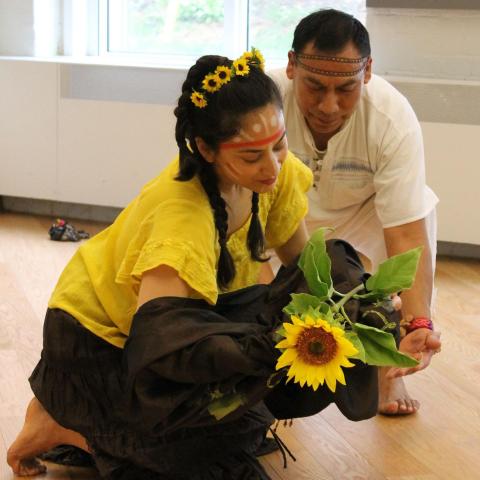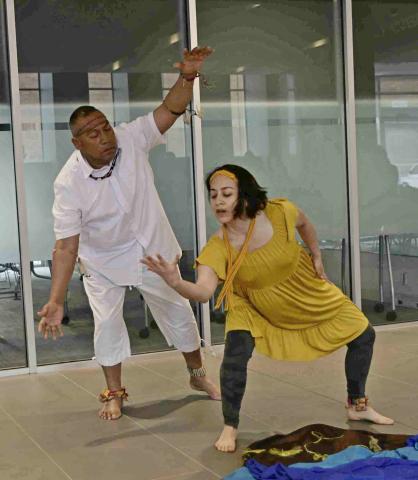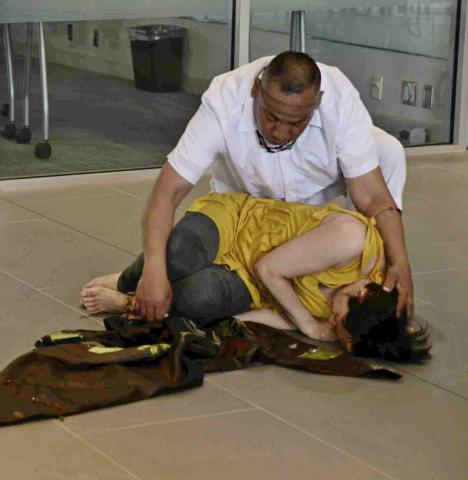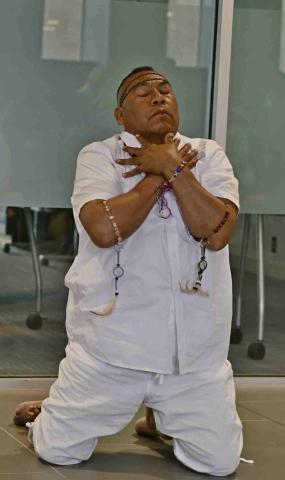The story of “The Sunflower Man,” a healing, community-based dance performance based on the life and work of migrant farmworkers.

For Latin American Heritage Month (marked in October in Canada) The United Church of Canada is celebrating our connections to Latina/o/x communities of faith and justice initiatives.
The Sunflower Man is a 15-minute dance piece that I co-created with Juan ‘Luis’ Mendoza de la Cruz (who goes by Luis), a migrant farm worker from Mexico. We developed this dance piece while I was conducting a study from 2015-2017 that explored Mexican and Guatemalan migrant farm workers’ participation in experiential “dance for relaxation” community arts sessions in the Niagara Region of Ontario. In this study, I implemented approaches commonly used in dance and movement therapy, which is based on the fundamental premise that, through dance, individuals both relate to the community that they belong to and are simultaneously able to express their own impulses and needs within that group. I facilitated a total of 10 experiential “dance for relaxation” sessions in Spanish at various locations, including an Anglican church, a grape vineyard, and a dance studio at my university.
As a novice researcher and dance artist with years of experience working in non-academic settings as a community cultural worker and social justice activist, I came to this study committed to improving the lives of Mexican and Guatemalan migrant farm workers. The root to my commitment stems from my personal experiences as a daughter of Guatemalan immigrant parents and my years of working with grassroots communities of immigrants and refugees forced to migrate to the United States and Canada due to rampant levels of violence, political unrest, and lack of employment opportunities in their countries of origin.
Juan Luis Mendoza de la Cruz is from the town of San Juan Tezompa, located an hour south of Mexico City. Luis has worked in the flower industry in the Niagara Region for 13 years and has been coming to Canada to work for a total of 30 years. I met Luis at an Anglican church in the Niagara Region that provides a Spanish mass each Sunday, along with a lunch program, a health clinic, and various social and recreational activities and holiday events for migrant farm workers. Luis was one of the participants in a couple of introductory body awareness dance workshops that I was offering at the church in Spanish for migrant farm workers.

Luis was just approaching his 50th birthday. He had been praying to God for something new to come into his life that would help him regain a new sense of hope. He was tired of being invisible and silently suffering from aches and pains in his body. His breathing had also become laboured due to inhaling toxins from pesticides, and that had landed him in the hospital a couple of years back. After attending the dance workshops, he was curious about using his body in different ways, rather than just as a working machine. He was eager to learn how to use dance as a way to express accumulated emotions and feelings without ever saying a single word.
Developing The Sunflower Man dance piece with Luis started in the sunflower fields on Sunday afternoons (his only day off) in August 2015 in the Niagara region. This co-creative process provided ample opportunities for us to develop a trusting relationship based on reciprocity and respect that came from the curiosity to explore movement and dance on the land that he has been caretaker of for several years. The stories evolved from Luis’ muscle memory as he demonstrated how he works the land and from the impulses and sensations that his body made in the moment as he interacted with the elements and the natural movement of the sunflowers.
The first time I set foot on Luis’ farm, I was greeted by acres upon acres of sunflowers at various stages of growth. They evoked a sense of curiosity and inspiration, and brought me back to memories of dancing on various natural landscapes with Dancing Earth Contemporary Indigenous Dance Creations’ summer dance intensives in Santa Fe, New Mexico. There, Dancing Earth’s Artistic Director Rulan Tangen introduced me to the concept of land dancing, which is the method that I used to guide and co-create the Sunflower Man dance with Luis.
Through my conversations with Luis on the land, I learned about what he does to prepare the soil to plant the seeds, the fertilization process, and the right time to harvest the sunflowers. All this became important themes that we later incorporated into a loosely choreographed dance piece entitled The Sunflower Man.
Luis returned to Mexico in October 2015, and I applied and was accepted to contribute a dance piece at an upcoming community festival in April 2016. When Luis returned to the Niagara Region for the 2016 harvest season, I told him that we had a venue and some seed money to work on co-creating the dance piece. He was elated for this unexpected opportunity.

The Sunflower Man dance made its debut in April 2016 at the In the Soil community arts festival in St. Catharines, Ontario. Many audience members who live in the Niagara Region commented that it was the first time that they have ever met a migrant farm worker! A few individuals from the audience alluded to the fact that they rarely see artistic works by local artists with a migrant justice focus and have never seen a migrant farm worker as the co-creator, much less a performer.
Luis and I also shared our dance piece to a group of 100 migrant farm workers (many of whom already knew Luis and I) at a special Mother’s Day event in 2016 for migrant mothers at a local Anglican Church. There were a couple of stories that were published about our collaboration by local Niagara-Region newspapers, including the Niagara Farmers’ Monthly. We also met Monica Gutierrez, a Colombian-born, Toronto-based filmmaker who was interested in documenting our creative process. Later, we received an unexpected call from Niki Ashton, a Member of Parliament from Manitoba, inviting us to present our dance at an event entitled The Precarious Generation: Millennials Fight Back on Parliament Hill in Ottawa, in October 2016. The Sunflower Man documentary is about the journey of taking our dance to Parliament Hill. We also presented our dance with Q and A at the University of Windsor, Concordia University, and at various festivals and events throughout the Niagara Region.
In May 2021, Juan 'Luis' Mendoza de la Cruz contracted COVID-19 in Mexico, along with several of his close family members. He passed away early on the morning of May 19, 2021. The power of creation and the powerful willingness to be vulnerable together will forever be embedded in my heart. Luis was a partner, father of three daughters, a grandfather, a poet, a musician, a knowledge keeper, a storyteller, a caretaker of the earth, a farmer, a spiritual man of great faith, a Mexican migrant farm worker for 30 years. His sunflower seeds of justice shared through his work and dance are a legacy will live on through the countless people that he has touched.
Luis confided in me his wish to leave a legacy for the next generation of migrant farm workers. He admitted that while migrant farm workers do experience marginalization, unfair treatment from employers and neglect due to the lack of safety training and healthcare services available to them, he was tired of migrant farm workers being seen from a deficit lens as poor victims of broken governmental systems. Like many migrant farm workers, Luis is concerned for his future, as he is uncertain how much longer he will be physically able to continue working and travelling to Canada. His dream is to be able to retire in Canada; knowing that this is not an option, he shared the following:
“I think that Canada owes me something. I have been working in this program for 26 years. I am 50 years old and I don’t know how much longer I will continue to come. What I don’t want is to be another worker who goes unrecognized. I no longer want to be invisible.”
— With limited and interrupted formal dance training; Heryka Miranda Pellecer's love of dance began as a young girl with break dance and tropical Latin dances in the streets and apartments of immigrant families in her neighbourhood in White Plains, New York. It wasn’t until she was in her early 30s that she began formal training in choreography under the mentorship of award-winning internationally known Indigenous and Latin American choreographers and multidisciplinary artists. Currently, Heryka is the Community Action Coordinator at Neighbour-2-Neighbour, Hamilton Community Food Centre. She also provides sessional instruction in the Faculty of Education and Faculty of Applied Health Sciences at Brock University.
The documentary, The Sunflower Man, by Colombian-born, Toronto-based filmmaker Monica Gutierrez debuted in April 2017 at Mayworks Festival in Toronto. It features the late Juan "Luis" Mendoza de la Cruz and Heryka Miranda Pellecer on their journey to bring the sunflower dance to Parliament Hill in Ottawa in October, 2016. This film is a part of Luis’ legacy of bringing justice and visibility to migrant farm workers in Canada. Directed by Monica Gutierrez, filmography by Perry Walker.

The views contained within these blogs are personal and do not necessarily reflect those of The United Church of Canada.